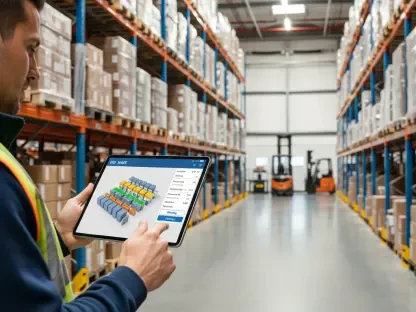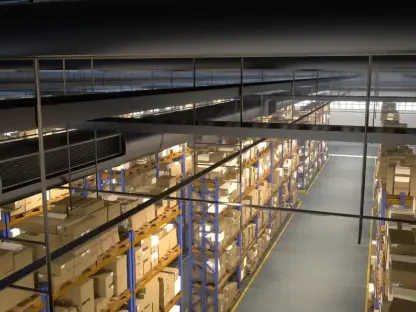The Fairfield Freight Hub is set to transform the logistics landscape in Canterbury, New Zealand. Located just north of Ashburton, this intermodal transport facility aims to enhance the efficiency of regional supply chain operations and significantly reduce the environmental and infrastructural strain caused by heavy truck traffic. This ambitious project, fully owned by the Mid Canterbury-based Wareing Group, represents a monumental leap toward a more sustainable and efficient freight system in the region.
Project Overview and Objectives
Enhancing Freight Volume Regulation
The core mission of the Fairfield Freight Hub is to ensure the operational efficiency and long-term viability of the Canterbury supply chain. Mark Wareing, a director at Wareing Group, emphasizes that the hub will streamline the regulation of freight volumes in and out of Mid Canterbury. By optimizing logistical coordination, the Fairfield Freight Hub aims to diminish the logistical burden on local roads and enhance sustainability through increased rail freight utilization.
Wareing highlights that the establishment of the Fairfield Freight Hub will provide a strategic solution for managing the region’s growing freight demands. With the hub’s advanced facilities and infrastructure, the project is poised to handle various aspects of freight, including the management of empty container supplies, export cargo ready for shipment, and import handling. This comprehensive approach ensures that the supply chain operates smoothly and efficiently, meeting the needs of manufacturers, exporters, and importers in Mid Canterbury and beyond.
Strategic Collaborative Efforts
The establishment of the hub is rooted in a collaborative spirit, with significant inputs from multiple stakeholders. The collaboration with Talleys, which secured the site at the former Silver Fern Farms meat processing plant’s existing rail siding, stands as a testament to the collective commitment towards regional logistics improvement. This partnership is expected to yield numerous operational benefits, contributing to a more efficient and environmentally friendly freight transport system.
The Fairfield Freight Hub’s collaboration with key partners underscores the importance of cooperative efforts in enhancing logistics operations. By working closely with Talleys and other stakeholders, the project leverages existing infrastructure and expertise, creating a seamless integration of road and rail transport. This collaborative approach not only optimizes freight handling but also reduces road congestion and lowers carbon emissions, aligning with broader environmental sustainability goals.
Funding and Economic Significance
Financial Investments and Contributions
The Fairfield Freight Hub’s development garnered an $18 million investment, encompassing substantial contributions from the government’s NZ Upgrade Programme ($2.5 million) and the Ashburton District Council ($2.3 million). These funds primarily focused on building a comprehensive staging model aimed at optimizing freight operational efficiencies, reducing unnecessary road transport movements, and enhancing sustainability.
The financial backing for the project illustrates a strong commitment from both governmental and local authorities to support regional economic growth and infrastructure development. These investments have been crucial in establishing the hub’s state-of-the-art facilities and ensuring its operational readiness. This significant capital injection provides the foundation for a more resilient and efficient logistics network, benefitting the entire Canterbury region.
Impact on Regional Economy
Speaking at a recent New Zealand grain and seed forum, Mark Wareing underscored the hub’s potential to cut costs and improve timeliness by aligning with trusted service partners. He sharply criticized the challenges faced by transport operators, particularly in congested areas like Christchurch’s Brougham Street, highlighting the need for more efficient logistics solutions. The Fairfield Freight Hub promises to ease these logistical hurdles, thereby boosting the regional economy.
Wareing’s remarks at the forum emphasize the critical role of the Fairfield Freight Hub in optimizing supply chain operations. By partnering with reputable service providers and leveraging the hub’s advanced infrastructure, the project aims to reduce logistical bottlenecks and improve the overall efficiency of freight transport. This, in turn, translates to cost savings for businesses and enhances the competitiveness of the regional economy, ensuring sustained growth and prosperity.
Strategic Infrastructure and Partnerships
Integration with KiwiRail
As part of a long-term agreement with KiwiRail, the Fairfield Freight Hub features a rail siding alongside container transfer services, warehouse storage, and grain handling facilities. This infrastructure is pivotal for managing increased freight volumes, significantly reducing heavy vehicle movements, which contribute to infrastructural wear and tear and carbon emissions. The hub’s connectivity between manufacturers, importers, exporters, and ports enhances its potential economic impact.
The strategic integration with KiwiRail is a cornerstone of the Fairfield Freight Hub’s operation. By incorporating rail transport into the logistics framework, the project mitigates the reliance on road transport and alleviates the strain on regional infrastructure. This holistic approach not only enhances the efficiency of freight movement but also aligns with sustainability goals by reducing the carbon footprint associated with heavy vehicle transport. The partnership with KiwiRail ensures a seamless and reliable connection between key logistics nodes, bolstering the overall effectiveness of the supply chain.
Role of Intermodal Hubs
Intermodal hubs like Fairfield are crucial for optimizing logistics operations. By facilitating truck movements for initial and final freight delivery stages while leveraging rail transport for long-distance transfers, these hubs enhance the efficiency and sustainability of the supply chain. The Fairfield Freight Hub, therefore, represents a significant step toward revolutionizing logistics in Canterbury.
The importance of intermodal hubs in modern logistics cannot be overstated. By combining the strengths of both road and rail transport, these hubs maximize the efficiency of freight operations and minimize the environmental impact. The Fairfield Freight Hub is set to serve as a model for future intermodal facilities, demonstrating how strategic infrastructure can revolutionize logistics networks. By providing a more streamlined and sustainable freight transport solution, the hub is poised to play a pivotal role in transforming the logistics landscape in Canterbury and beyond.
Operational Capacity and Environmental Impact
Facilities and Services
The Fairfield Freight Hub spans a four-hectare facility approved by the Ministry for Primary Industries. It boasts an array of facilities, including dry storage warehouses, general container storage, secure export scheme approval, bulk grain testing and consolidation, and facilities for container fumigation and cleaning. KiwiRail projects that the hub will increase local freight transported by rail from 6,000 to 20,000 containers annually, significantly reducing road congestion and associated environmental impacts.
The hub’s extensive facilities are designed to handle a wide range of freight requirements, ensuring that various logistics needs are met efficiently. By providing specialized services such as bulk grain testing and container fumigation, the Fairfield Freight Hub offers a comprehensive solution for businesses involved in the import and export of goods. This, coupled with the projected increase in rail freight capacity, highlights the hub’s pivotal role in enhancing the regional supply chain and minimizing the environmental footprint of freight operations.
Environmental Benefits
Rail transport generates 70% fewer emissions compared to traditional truck freight. By taking half a million tonnes of freight off regional roads—equivalent to 40,000 truck movements—the Fairfield Freight Hub promises to deliver substantial environmental benefits. This significant reduction in emissions aligns with broader sustainability goals, making the hub a vital asset for Canterbury’s logistics network.
The environmental benefits of the Fairfield Freight Hub extend beyond emission reductions. By alleviating road congestion and reducing heavy vehicle movements, the hub also contributes to improved road safety and decreased infrastructural wear and tear. This holistic approach to sustainability ensures that the hub not only meets the logistics needs of the region but also supports broader environmental and socio-economic objectives. The Fairfield Freight Hub serves as a prime example of how strategic infrastructure development can drive positive environmental outcomes, paving the way for a greener and more sustainable future for Canterbury.
Industry Collaboration and Future Outlook
Enhancing Efficiency Through Technology
Paul Dinnington, a KiwiRail account executive, referred to the Fairfield operation as one of six South Island export container hubs that serve as buffers for timely container delivery to ports. The introduction of a new customer booking portal with live data is set to enhance the efficiency of booking supply chains and connector routes with road transport, ensuring smoother logistics operations.
The implementation of advanced technology, such as the new customer booking portal, is a key factor in the Fairfield Freight Hub’s success. By providing real-time data and streamlining the booking process, the portal enhances the overall efficiency and reliability of the logistics network. This technological innovation ensures that supply chain operations are coordinated seamlessly, reducing delays and improving the timeliness of freight delivery. The use of cutting-edge technology underscores the hub’s commitment to continuous improvement and adaptation to evolving logistics demands.
Strategic Partnerships for Cost Reduction
The Fairfield Freight Hub is poised to revolutionize the logistics landscape in Canterbury, New Zealand. Strategically situated just north of Ashburton, this state-of-the-art intermodal transport facility aims to boost the efficiency of regional supply chain operations while significantly cutting down on the environmental and infrastructural burdens caused by heavy truck traffic. This cutting-edge project is fully owned by the Wareing Group, a company based in Mid Canterbury, and signifies a monumental stride toward creating a more sustainable and efficient freight system in the area.
The development of this hub is anticipated to bring several benefits to the region, such as improved logistics coordination, faster delivery times, and reduced congestion on local roads. By decreasing reliance on long-haul trucking, the Fairfield Freight Hub will help lower greenhouse gas emissions, thus contributing to New Zealand’s environmental goals. Additionally, this hub is expected to generate new job opportunities and boost the local economy, further solidifying the Wareing Group’s commitment to community growth and development.









